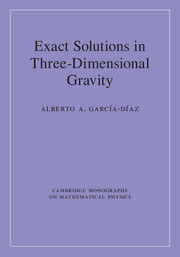Book contents
- Frontmatter
- Contents
- Preface
- 1 Introduction
- 2 Point Particle Solutions
- 3 Dust Solutions
- 4 A Shortcut to (2+1) Cyclic Symmetric Stationary Solutions
- 5 Perfect Fluid Static Stars; Cosmological Solutions
- 6 Static Perfect Fluid Stars with Λ
- 7 Hydrodynamic Equilibrium
- 8 Stationary Circularly Symmetric Perfect Fluids with Λ
- 9 Friedmann–Robertson–Walker Cosmologies
- 10 Dilaton–Inflaton Friedmann–Robertson–Walker Cosmologies
- 11 Einstein–Maxwell Solutions
- 12 Black Holes Coupled To Nonlinear Electrodynamics
- 13 Dilaton Field Minimally Coupled to (2 + 1) Gravity
- 14 Scalar Field Non-Minimally Coupled to (2+1) Gravity
- 15 Low-Energy (2+1) String Gravity
- 16 Topologically Massive Gravity
- 17 Bianchi-Type (BT) Spacetimes in TMG; Petrov Type D
- 18 Petrov Type N Wave Metrics
- 19 Kundt Spacetimes in TMG
- 20 Cotton Tensor in Riemannian Spacetimes
- References
- Index
8 - Stationary Circularly Symmetric Perfect Fluids with Λ
Published online by Cambridge University Press: 30 August 2017
- Frontmatter
- Contents
- Preface
- 1 Introduction
- 2 Point Particle Solutions
- 3 Dust Solutions
- 4 A Shortcut to (2+1) Cyclic Symmetric Stationary Solutions
- 5 Perfect Fluid Static Stars; Cosmological Solutions
- 6 Static Perfect Fluid Stars with Λ
- 7 Hydrodynamic Equilibrium
- 8 Stationary Circularly Symmetric Perfect Fluids with Λ
- 9 Friedmann–Robertson–Walker Cosmologies
- 10 Dilaton–Inflaton Friedmann–Robertson–Walker Cosmologies
- 11 Einstein–Maxwell Solutions
- 12 Black Holes Coupled To Nonlinear Electrodynamics
- 13 Dilaton Field Minimally Coupled to (2 + 1) Gravity
- 14 Scalar Field Non-Minimally Coupled to (2+1) Gravity
- 15 Low-Energy (2+1) String Gravity
- 16 Topologically Massive Gravity
- 17 Bianchi-Type (BT) Spacetimes in TMG; Petrov Type D
- 18 Petrov Type N Wave Metrics
- 19 Kundt Spacetimes in TMG
- 20 Cotton Tensor in Riemannian Spacetimes
- References
- Index
Summary
In the theory of black holes, an important place is assigned to the problem of their interior: understanding it as the matter that generates the external gravitational field. Commonly, the matter is modeled through a perfect fluid. It is worth recalling that in (3 + 1) gravity the interior solution to the Schwarzschild black hole is modeled by an interior Schwarzschild perfect fluid solution with constant energy density, but the question still remains open as to what is the interior solution for the rotating Kerr black hole? In (2+1) gravity one may ask the same question with respect to the rotating BTZ black hole. As we shall see in this chapter, there is an interior solution to the BTZ black hole, modeled by a perfect fluid with constant energy density. Moreover, we succeeded in deriving perfect fluid solutions, such that their fluid velocity possesses differential rotation. On the other hand, rigidly rotating exact perfect fluid solutions derived by Rooman and Spindel (1998) and Lubo et al. (1999) are also reported. Those papers deal with stationary circularly symmetric gravitational sources of the perfect fluid type, with a cosmological constant with focus on restrictions on the physical parameters of the solutions due to the matching conditions between the interior and exterior geometries. In particular, it is established there that finite sources and absence of closed timelike curves privilege negative values of the cosmological constant. Moreover, for stationary configurations, the field equations for constant energy densities have been explicitly solved; if, additionally, the pressure vanishes, interior Gödel-like stars arise.
It is worth pointing out that the literature on stationary perfect fluid solutions of (2+1) gravity is rather scarce; among it one may cite Rooman and Spindel (1998); Lubo et al. (1999); García (2004); Cataldo (2004); Gürses (1994); Obukhov (2003). From Section 8.1 to Section 8.2.5 I follow the presentation given in García (2004), while for the remaining two sections I follow Rooman and Spindel (1998), and Lubo et al. (1999).
- Type
- Chapter
- Information
- Exact Solutions in Three-Dimensional Gravity , pp. 92 - 107Publisher: Cambridge University PressPrint publication year: 2017



